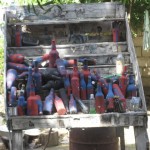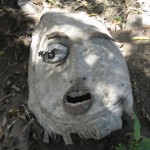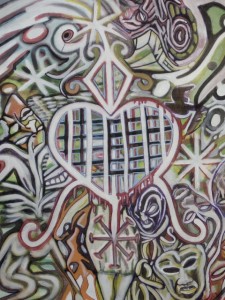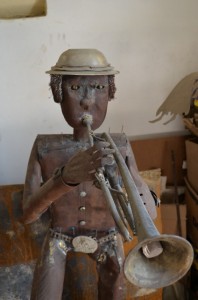Voodoo Inspired – The Sum of Our Ancestors
![2659[2]](https://blog.itscactus.com/wp-content/uploads/2012/12/26592-137x300.jpg)
This composite figure is a masterpiece of Voodoo imagery
The Loa are, of course, the spirits of Voodoo, and within their ranks are prominent, universal Loa, such as Papa Legba, Erzulie Freda, The Marassa Twins, etc. However, there are other, less “famous” though equally important Loa to those that follow the practice of Voodoo: the Loa of the individual’s ancestral family.
At the head of this ancestral family are Damballah Wedo and Aida Wedo, the oldest ancestors. They are the mother and

A Voodoo altar typically holds colorful bottles of drink for the Loa to enjoy during their visits.
father of all things powerful and good, and together they possess the ancestral knowledge that forms the foundation of Voodoo. They are both symbolized by serpents and from them, the ancestors of the individual are descended.
According to “Sosyete du Marche” an American Voodou society, there are two sources of holy truth: the universe around us and the universe within us, passed down from our ancestors as instinct, emotion, predisposition, and memory. Ancestors are like their descendants but more powerful; living, loving, understanding, and communicating on a plane of reality that is beyond death. Communion with the ancestors is a means of maintaining continuity and a basis of transcendence between life and the afterlife.
The individual, as the flesh and blood sum of his ancestors, is a synthesized version of all those who have gone before. To fail to honor them then, is to court disaster and to put into jeopardy the lives of those

Mask of a wandering soul
family members yet to come. It would be as if the lifeline were broken. In fact, by this philosophy, recently deceased family members
must have a ritual performed on their behalf by a hougan, or priest, to ensure that their souls can go peacefully to the place of eternal afterlife. Later, the deceased can be consulted and entreated to bestow wisdom and blessings upon the family. Conversely, the dishonored soul, aimless and restless, will
wander the earth, leaving illness and destruction in its wake.
With all of this in mind, it seems as if many of the pieces contained within the “Voodoo Inspired” design section are sculptural celebrations, not only of Voodoo spirits, but of Voodoo Spirit. See if you agree…
Third in the series, “Voodoo Inspired”
Contributed by Linda for Beyond Borders/It’s Cactus

![sm355[1]](https://blog.itscactus.com/wp-content/uploads/2012/12/sm35511-218x300.jpg)


![2691[1]](https://blog.itscactus.com/wp-content/uploads/2012/12/269112.jpg)

![sm413[1]](https://blog.itscactus.com/wp-content/uploads/2012/08/sm41311-133x300.jpg) When a sculpture is selected to be sold in the Beyond Borders catalogue or on our website, we photograph it, give it an inventory number, and a name. This one, for what may be obvious reasons, we chose to name “Double Trouble.” The impish looks on these faces, the hair standing on end, the shape of the mouths – all of that said, “Uh-oh” to us. “Double Trouble,” absolutely. It’s cute, it’s catchy. Maybe someone with twins will buy it.
When a sculpture is selected to be sold in the Beyond Borders catalogue or on our website, we photograph it, give it an inventory number, and a name. This one, for what may be obvious reasons, we chose to name “Double Trouble.” The impish looks on these faces, the hair standing on end, the shape of the mouths – all of that said, “Uh-oh” to us. “Double Trouble,” absolutely. It’s cute, it’s catchy. Maybe someone with twins will buy it.![image005(231)[1]](https://blog.itscactus.com/wp-content/uploads/2012/08/image0052311-220x300.jpg)
![images[1]](https://blog.itscactus.com/wp-content/uploads/2012/08/images1.jpg) They successfully grafted the leg of a recently dead black man onto a disabled white man, who was thus able to walk again.
They successfully grafted the leg of a recently dead black man onto a disabled white man, who was thus able to walk again.